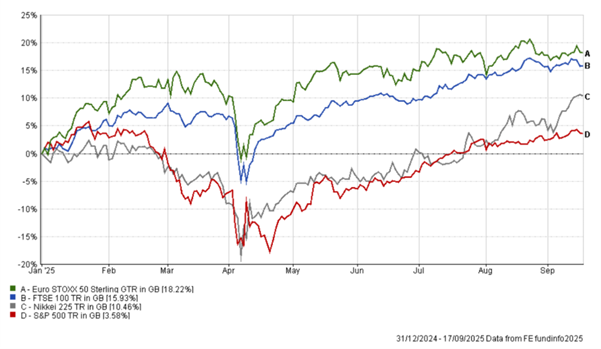Executive Summary
Fed cuts rates for the first time in 2025, easing to 4.0–4.25% as inflation moderates.
- U.S. tariffs face Supreme Court scrutiny, adding policy risk and market volatility.
- UK holds base rate at 4.0%, citing sticky inflation; QT scaled back to calm gilt markets.
- Global equities mixed: U.S. lifted by Fed cut, UK and Europe supported by valuations, Asia and India remain growth leaders.
- Gold strengthens as safe-haven demand rises, copper stays elevated under tariff strain.
Global Equities:
Equity performance diverged across regions in September. U.S. markets responded positively to the Fed’s first rate cut, though concentration risk in the “Big 7” technology names remains a concern. UK and European markets benefited from relatively attractive valuations and a weaker pound and euro against the dollar, providing a tailwind for exporters. In Asia, Japan’s corporate reforms and strong earnings continued to drive investor flows, while India remained one of the most compelling growth stories globally, supported by demographics, domestic demand, and relative insulation from U.S. tariff disputes.
Tariffs, Courts & Fed Lift the Veil of Certainty
U.S. markets entered September on edge as the Supreme Court began hearing a case challenging the constitutional basis of the “Liberation Day” tariffs. A ruling is expected later this year, and uncertainty over whether the regime will be upheld or struck down has led companies to hold back investment and has injected volatility into equity markets.
The Federal Reserve delivered its first rate cut of 2025, trimming the federal funds rate to 4.0–4.25%. Chair Powell cited a softer labour market and moderating inflation, though he acknowledged that tariffs remain a risk to price stability. Markets now expect at least one further cut before year-end, helping push U.S. equities higher despite the trade overhang.
UK holds its nerve amid inflation pressures
The Bank of England kept its base rate at 4.0% in September, after five cuts over the past year. Two Monetary Policy Committee members voted for an immediate reduction to 3.75%, but the majority argued that inflation was proving sticky.
UK CPI inflation was 3.8% year-on-year in August, unchanged from July. Food and housing costs remain the key drivers, while core inflation shows only gradual easing. With inflation still well above target, policymakers opted to pause.
The BoE also scaled back its quantitative tightening programme, reducing planned gilt sales from £100bn to £70bn per year — a supportive move for bond markets. Fiscal policy remains constrained ahead of the Autumn Statement, leaving Chancellor Reeves limited room for manoeuvre as growth indicators weaken and unemployment drifts higher.
Other viewpoints:
Cash
With the BoE base rate held at 4.0%, instant access accounts still offer around 4.0–4.2%, while fixed-term deals continue to slip. If rates fall further, this could be the last chance to secure fixed returns near 4%. Short-term locking looks attractive for investors seeking certainty as policy heads lower.
Fixed Interests
UK gilts firmed after the BoE slowed its QT programme, with 10-year yields easing toward 4.3–4.4%. U.S. Treasuries rallied after the Fed’s cut, especially at the short end. Falling global policy rates support existing bond values, providing a partial recovery from 2022’s declines.
Alternatives
Gold extended its rise as rate cuts and trade uncertainty supported safe-haven demand. Silver followed suit. Oil prices were volatile, hovering in the low-70s per barrel amid Middle East supply jitters. Copper remains elevated due to tariffs, raising costs for industry worldwide. Inflation concerns and geopolitical risks keep gold attractive as a hedge.
UK Shares
The FTSE 100 remains resilient, supported by global exporters benefiting from a softer pound. Domestically focused shares lag as consumer demand weakens, but overall valuations remain compelling. Compared with the U.S., UK equities continue to trade at a discount, and we see scope for gradual upside, particularly if inflation softens further.
US Shares
Equities rallied on the Fed’s rate cut, but policy risk remains elevated. The “Big 7” tech firms now make up close to 40% of the S&P 500’s value, raising concentration concerns. AI integration continues to drive enthusiasm, but overvaluation looms large. Immigration restrictions and tariffs are fuelling labour shortages and higher costs, which may add to inflationary pressure. While U.S. indices may grind higher, we see better value elsewhere in the short to medium term.
European Shares
European equities posted steady gains, with the DAX and Euro Stoxx 50 near record highs. The euro looks undervalued, offering scope for appreciation as the dollar weakens. Earnings growth may be modest, but valuations remain attractive, making Europe a long-term opportunity despite U.S. trade headwinds.
Asian Shares
Japan continues to perform strongly, supported by corporate reforms and robust earnings. China remains uneven — consumer demand is improving, but manufacturing softness persists. India remains a standout story, with demographics, demand growth, and limited tariff exposure making it a compelling growth market.
Emerging Markets
EM equities advanced, helped by a weaker dollar and stronger commodity prices. Latin America attracted inflows, though Brazil still suffers from tariff and political risk. Selectivity is key: exporters of commodities and tech-linked EMs offer opportunities, while heavily indebted markets remain vulnerable.
Highlights & Risks
Highlights:
- U.S. rate cut eases conditions; equities respond positively.
- BoE holds rates but slows QT, helping gilts.
- Gold maintains safe-haven appeal amid trade and inflation uncertainty.
- UK and European equities look undervalued versus U.S. peers.
- India and Japan remain regional bright spots in Asia.
Risks:
- Supreme Court ruling on U.S. tariffs could trigger major market repricing.
- UK inflation remains stubborn, limiting scope for rapid BoE easing.
- Overvaluation and concentration risk in U.S. tech remain high.
- Global manufacturing weakness threatens earnings outlook.

